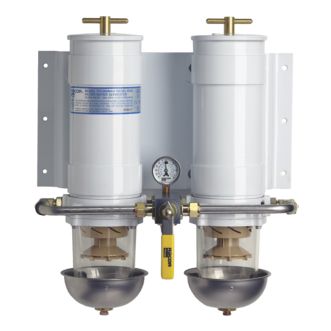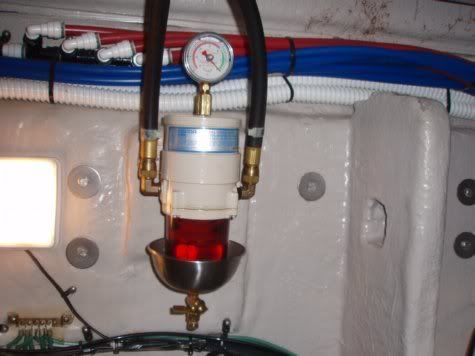osd9
New Member
Frank: I hear your points and I understand your logic..... but, just to continue with the discussion ........Let's say I have a set of dual 900MA filters.......which in my case, a single 900MA alone would offer tons of fuel flow margin to begin with.......and I run one in standby.
I regularly inspect my bilge, and part of my inspection includes noting the vacuum guage on my filters.
I fill up with a new load of fuel and go on a planned 3 hour cruise....hmmmm....where did I hear that before....Anyway....1 hour into the cruise....rut roh....things ain't going so well. I pull back the throttles and head down into the bilge. I notice my filter vacuum guages indicate that my active filter is in the early stages of clogging. So.....I switch to the standby filter. I note it took ~1 hour to get to this point on the active filter, so I can make a realtively confident assumption that I've got probably another hour before my standby filter starts to act up. Important to note is.....I now know that I've got an issue. At that point, I can throttle back and assess the situation....I can call for help, swap out the active filter....or make a B-line for the nearsest safe port.....which may mean just turn around and go home. If, my calculation is wrong, and the second filter starts to exhibit the same issue....I still have the option to put them both online again and limp home....but...the difference is....I had options.
Now....I've never had a filter clog on me. I generally get my fuel from a realiable source. So, I am only guessing on what will happen in a situation where my filter clogs.
I regularly inspect my bilge, and part of my inspection includes noting the vacuum guage on my filters.
I fill up with a new load of fuel and go on a planned 3 hour cruise....hmmmm....where did I hear that before....Anyway....1 hour into the cruise....rut roh....things ain't going so well. I pull back the throttles and head down into the bilge. I notice my filter vacuum guages indicate that my active filter is in the early stages of clogging. So.....I switch to the standby filter. I note it took ~1 hour to get to this point on the active filter, so I can make a realtively confident assumption that I've got probably another hour before my standby filter starts to act up. Important to note is.....I now know that I've got an issue. At that point, I can throttle back and assess the situation....I can call for help, swap out the active filter....or make a B-line for the nearsest safe port.....which may mean just turn around and go home. If, my calculation is wrong, and the second filter starts to exhibit the same issue....I still have the option to put them both online again and limp home....but...the difference is....I had options.
Now....I've never had a filter clog on me. I generally get my fuel from a realiable source. So, I am only guessing on what will happen in a situation where my filter clogs.





